Perched as we are on the edge of the North American continent with the Pacific Ocean continuously nipping at our heels, it’s no surprise that Bay Area visual artists look to the water for inspiration.
Addressing rising sea levels, the maritime history of San Francisco, the creatures who dwell beneath the surface and the very substance of our watery surroundings, local artists are tapping into a rich underwater terrain.
As KQED joins the BBC at the Monterey Aquarium for a three-day maritime extravaganza, BIG BLUE LIVE in the coming days, KQED Arts marks the occasion with profiles of 10 Bay Area artists mining the depths of that same ocean.
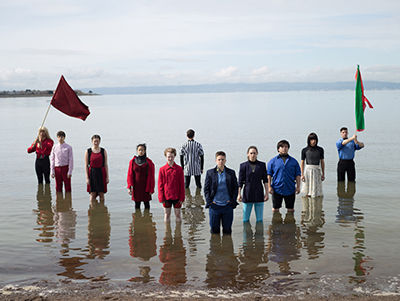
Kim Anno
In her ongoing project Men and Women in Water Cities, painter and multimedia artist Kim Anno creates large-scale events in collaboration with actors, composers and dancers that culminate as finely-edited films. Most recently, Water City: Berkeley asks, “What is the future when the seas have entered the cities?” Among the half-submerged performers, chants from Oedipus Rex, pom-pom wielding cheerleaders and crowds of people running through wet sand, Anno paints a picture of a deranged yet poetic society attempting make meaning in a newly watery world.
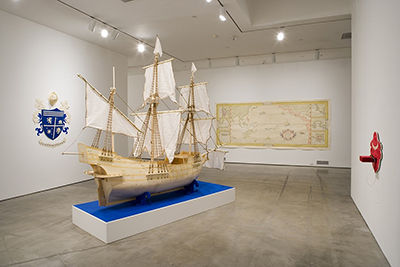
Michael Arcega
Michael Arcega’s playful approaches to language, the history of colonization and other uneven power dynamics often center around bodies of water. In 2001, he constructed a miniature Manila galleon out of manila folders, christened the ship “El Conquistadork” and successfully rowed it around Tomales Bay, a historical stop along a famed, centuries-long trade route between Mexico City, Manila and California. Ten years later, Arcega built “Baby,” a collapsible Pacific outrigger canoe. The artist sailed the vessel in numerous bodies of water across the United States, reversing the path of Manifest Destiny by bringing a Pacific ship to the Atlantic.
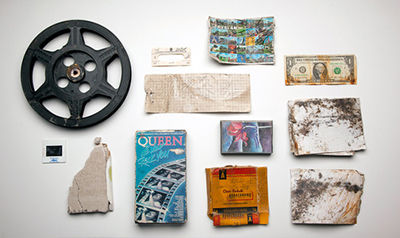
Amy Balkin
Amy Balkin’s ongoing A People’s Archive of Sinking and Melting is a collection of items from places around the world that may disappear due to the effects of climate change, whether that’s rising sea levels, melting glaciers, desertification or coastal erosion. By asking the public to contribute items, the archive argues for climate change as a series of personal experiences rather than a set of abstract figures. Venetian confetti joins detritus from New Orleans and a growing California collection to document a changing world we all occupy and can’t ignore.
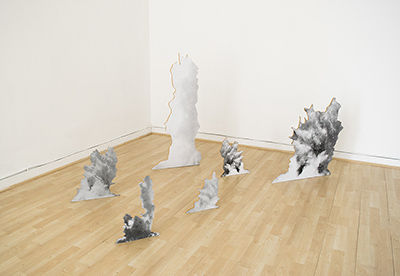
Marshall Elliott
For his series The Hidden Can Still Wreck You and Would Be Better Made Visible, Marshall Elliott adopts different material forms, such as sculpture, video, works on paper, commemorative plates, to represent the invisible. His focus? The Bedrock Knobs of San Francisco — small rocks in the San Francisco Bay that met an explosive fate at the end of the 19th century when the US Army Corps of Engineers blasted the rocks as navigation hazards, forever altering the natural landscape of the Bay. Elliott’s work, small-scale gestures honoring formations deemed too dangerous to exist, respectfully pull a forgotten bit of Bay Area history from the depths of obscurity.
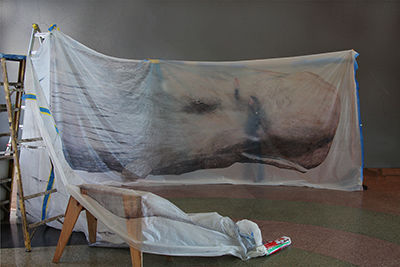
Alicia Escott
When Alicia Escott moved her studio from the Mission to the Outer Sunset more than three years ago, her practice shifted accordingly. In Letters Sent Sometime After The Continents Separated, the artist writes missives to extinct or soon-to-be extinct species in the voice of a former lover, filling them in on all that’s happened since they disappeared. Once such letter, addressed to the blue whale and dated from 2105, is tragic and funny: “Ironically there is more water here than ever. It is difficult to reconcile my longing for you and our days by the sea, amid soaring prices for landlocked real-estate in a world much underwater. Between the foghorn calls, on stormy days, sometimes I think I almost hear your voice.”
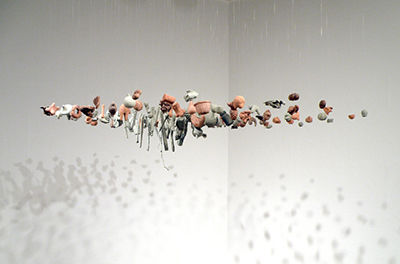
Tanja Geis
Recent UC Berkeley MFA graduate Tanja Geis uses material pulled from the San Francisco Bay across media: mud becomes pigment in her large-scale works on paper, objects pulled from the water form hanging sculptures and underwater footage creates mesmerizing video. Not only did her work force me to look up the meaning of the word “littoral” (of, relating to, or situated on the shore of the sea or a lake), it asks the viewer to turn their understanding of the world upside down and see what’s concealed just below the surface.
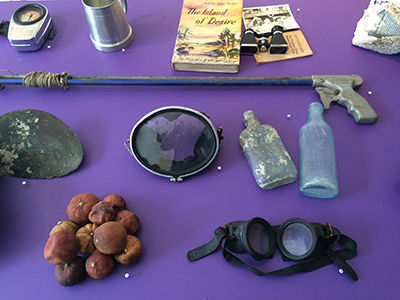
Lauren Hartman
For the past few years, mixed media artist Lauren Hartman has focused her practice on human interactions with the sea. From embroideries of oil rig explosions to paintings of shipwrecks made with gold leaf and mother of pearl on panel, she painstakingly renders the follies of our attempts to harness nature. A recent social practice project, Society of Submerged Culture brought together historians, explorers, archeologists, artists, underwater enthusiasts, sailors and swimmers to document and discuss the history of San Francisco (a city built on top of abandoned Gold Rush-era ships) and its coastline.
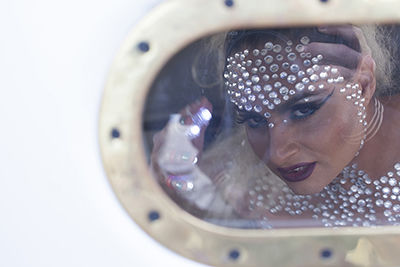
Constance Hockaday
Constance Hockaday’s boat-related projects have taken her from Far Rockaway, Queens to Treasure Island’s Clipper Cove as she creates temporary communities on the water in response to changing economic and social conditions on dry land. For All These Darlings and Now Us, Hockaday invited dancers and patrons from the recently-closed Lusty Lady and Esta Noche (a North Beach worker-owned strip club and a Mission district Latino gay bar, respectively) to participate in a floating peepshow, celebrating the temporary freedom of life offshore.
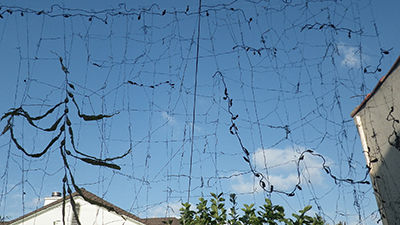
Dimitra Skandali
Raised on the Greek island of Paros, Dimitra Skandali routinely references the ocean in her installation and sound-based work. Her recent exhibition at Alter Space turned the subterranean gallery into the closest thing to a sea cave you’ll get on dry land. Using simple materials — steel wool, wire, strands of sea grass and reflected light — she created a space that was at once magical and claustrophobic, accurately channeling both the beauty and danger of the sea.
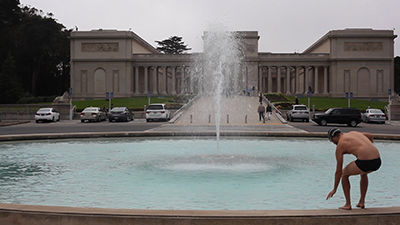
Chris Sollars
Multimedia artist Chris Sollars has long engaged with the watery edges of San Francisco, but nowhere so completely as in his 2013 solo show at Steven Wolf Fine Arts, The Swimmer. Works in the delightfully-deadpan exhibit included barnacle-encrusted objects, documentation of Sollars walking the entire San Francisco coastline from Candlestick Point to Ocean Beach and a video inspired by John Cheever’s short story “The Swimmer,” in which Sollars traverses the city via bodies of water, from public swimming pool to dinky plaza fountain.